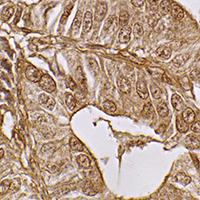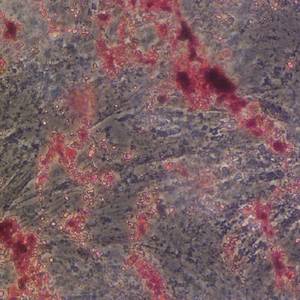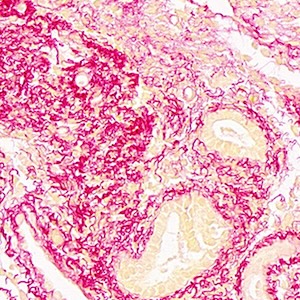Immunopositivity for Siglec-15 in gastric cancer and its association with clinical and pathological parameters

Submitted: 23 August 2020
Accepted: 9 February 2021
Published: 4 March 2021
Accepted: 9 February 2021
Abstract Views: 3035
PDF: 868
Supplementary: 160
HTML: 6
Supplementary: 160
HTML: 6
Publisher's note
All claims expressed in this article are solely those of the authors and do not necessarily represent those of their affiliated organizations, or those of the publisher, the editors and the reviewers. Any product that may be evaluated in this article or claim that may be made by its manufacturer is not guaranteed or endorsed by the publisher.
All claims expressed in this article are solely those of the authors and do not necessarily represent those of their affiliated organizations, or those of the publisher, the editors and the reviewers. Any product that may be evaluated in this article or claim that may be made by its manufacturer is not guaranteed or endorsed by the publisher.
Similar Articles
- E. Akat, H. Arıkan, B. Göçmen, Histochemical and biometric study of the gastrointestinal system of Hyla orientalis (Bedriaga, 1890) (Anura, Hylidae) , European Journal of Histochemistry: Vol. 58 No. 4 (2014)
- D.G.B. Araújo, L. Nakao, P. Gozzo, C.D.A. Souza, V. Balderrama, E.S. Gugelmin, A.P. Kuczynski, M. Olandoski, L. de Noronha, Expression level of quiescin sulfhydryl oxidase 1 (QSOX1) in neuroblastomas , European Journal of Histochemistry: Vol. 58 No. 1 (2014)
- Arturo Mangas, Javier Yajeya, Noelia González, Isabel Ruiz, Marianny Pernía, Michel Geffard, Rafael Coveñas, Gemst: a taylor-made combination that reverts neuroanatomical changes in stroke , European Journal of Histochemistry: Vol. 61 No. 2 (2017)
- M. Lehmann, F. Martin, K. Mannigel, K. Kaltschmidt, U. Sack, U. Anderer, Three-dimensional scaffold-free fusion culture: the way to enhance chondrogenesis of in vitro propagated human articular chondrocytes , European Journal of Histochemistry: Vol. 57 No. 4 (2013)
- Damián Sánchez-Ramírez, Rafael Medrano-Guzmán, Fernando Candanedo-González, Jazmín De Anda-González, Luis Enrique García-Rios, Vadim Pérez-Koldenkova, Marcos Gutiérrez-de la Barrera, Sara Rodríguez-Enríquez, Marco Velasco-Velázquez, Silvia Cecilia Pacheco-Velázquez, Patricia Piña-Sánchez, Héctor Mayani, Alejandro Gómez-Delgado, Alberto Monroy-García, Ana Karen Martínez-Lara, Juan José Montesinos, High expression of both desmoplastic stroma and epithelial to mesenchymal transition markers associate with shorter survival in pancreatic ductal adenocarcinoma , European Journal of Histochemistry: Vol. 66 No. 1 (2022)
- K. Fukui, T. Yasui, H. Gomi, H. Sugiya, O. Fujimori, W. Meyer, A. Tsukise, Histochemical localization of sialic acids and antimicrobial substances in eccrine glands of porcine snout skin , European Journal of Histochemistry: Vol. 56 No. 1 (2012)
- Yankun Wang, Yuning Liu, Yawei Wang, Ao Zhang, Wenqian Xie, Haolin Zhang, Qiang Weng, Meiyu Xu, Investigation of seasonal changes in lipid synthesis and metabolism-related genes in the oviduct of Chinese brown frog (Rana dybowskii) , European Journal of Histochemistry: Vol. 67 No. 4 (2023)
- T. Nara, T. Yasui, O. Fujimori, W. Meyer, A. Tsukise, Histochemical properties of sialic acids and antimicrobial substances in canine anal glands , European Journal of Histochemistry: Vol. 55 No. 3 (2011)
- Cristina Pirrone, Anna M. Chiaravalli, Alessandro Marando, Andrea Conti, Alessia Rainero, Andrea Pistochini, Francesco Lo Curto, Francesco Pasquali, Paolo Castelnuovo, Carlo Capella, Giovanni Porta, OTX1 and OTX2 as possible molecular markers of sinonasal carcinomas and olfactory neuroblastomas , European Journal of Histochemistry: Vol. 61 No. 1 (2017)
- Roberta Sferra, Simona Pompili, Claudio Festuccia, Francesco Marampon, Giovanni L. Gravina, Luca Ventura, Ernesto Di Cesare, Sara Cicchinelli, Eugenio Gaudio, Antonella Vetuschi, The possible prognostic role of histone deacetylase and transforming growth factor β/Smad signaling in high grade gliomas treated by radio-chemotherapy: a preliminary immunohistochemical study , European Journal of Histochemistry: Vol. 61 No. 2 (2017)
You may also start an advanced similarity search for this article.

 https://doi.org/10.4081/ejh.2021.3174
https://doi.org/10.4081/ejh.2021.3174















